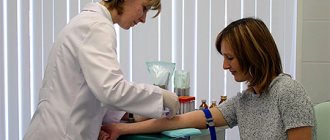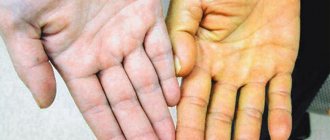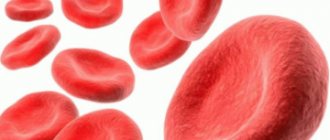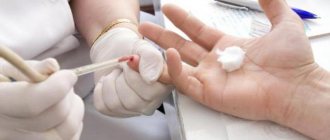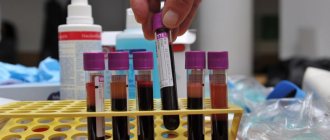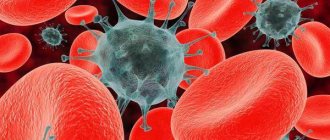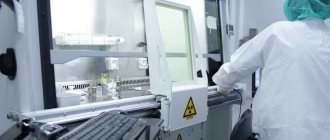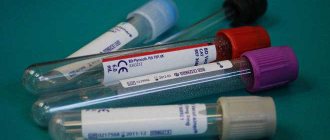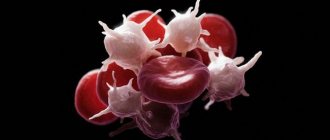There are many serious diseases that make people suffer. One of these is blood hemolysis. When such people undergo tests, disturbances in the physiological process are observed - the formation and breakdown of red blood cells. This article will help you understand what this problem is, its causes, symptoms and treatment methods.
Types of hemolysis
Hemolysis is classified according to the method of development:
- Physiological is a natural, necessary process, as a result of which the death of red blood cells occurs due to the fact that they have already fulfilled all their functions and can no longer perform them. Their place is immediately taken by new cells.
- Electrical – caused due to electric shock, which usually occurs due to non-compliance with safety rules when using various devices in the home.
- Biological - develops as a result of the influence of the venom of insects, snakes, various microorganisms, after a blood transfusion from a donor in case of incompatibility.
- Thermal - occurs against the background of freezing and thawing, since these actions are characterized by the formation of ice crystals in red blood cells, and thawing leads to their rupture.
- Mechanical - as a result of impact, for example, if you shake a test tube containing blood.
- Chemical – develops due to reagents of a chemical nature (chloroform, alcohols, alkalis, ethers, etc.). Thus, the destruction of the erythrocyte membrane is observed, and hemoglobin is released.
- Osmotic - caused by the environment in which the red blood cells are trapped, where the osmotic pressure is lower than in the blood fluid.
In addition, there are classifications by location:
- Intravascular hemolysis - red blood cells are destroyed when involved in the process of blood circulation. Signs of this condition include increased levels of free hemoglobin, as well as hemosiderin.
- Intracellular hemolysis - red blood cells are found in organs that take part in blood formation or the accumulation of formed blood elements.
Diagnostics
To determine how high the density of the erythrocyte membrane is, the osmotic resistance technique is used. The test allows you to identify 2 types of shell destruction - minimal and maximum. Considering how harmful the NaCl solution is to red cells, it is in the container with it that the blood samples selected for research are placed. When the concentration of the resulting solution varies between 0.46-0.48%, it means that the density of the blood cell membranes is quite good and they do not die in this substance. This test is called minimal resistance. And the maximum resistance is calculated when the solution concentration is 0.34%. Under such conditions, all red blood cells die.
Types of hemolysis
Young blood cells are more resistant to destruction due to their unique shape, but mature red blood cells in the form of balls are quickly destroyed. A hypertonic solution for determining the density of cell membranes can have different concentrations, and in each case the effect on the vital activity of red blood cells will change.
For example, saline solution is actively used, which does not harm the blood, but stimulates the replenishment of intravascular blood volumes. This need arises in case of severe bleeding. The membranes of red blood cells from the NaCl solution are strengthened, and hemoglobin does not break out.
Hemolysis index
The hemolysis index is a special test that determines the quantitative content of hemoglobin in the patient’s blood, and also involves a visual examination of the biomaterial.
If this syndrome was discovered during the study, the attending physician is obliged to refer the patient for re-analysis. This is necessary in order to eliminate the human factor, namely non-compliance with the rules for blood collection, storage, and delivery.
The following values are considered normal (*106/µl):
- for women – 3.9-5.3;
- for men – 4.3-5.7.
The study also focuses on hematocrit. This term refers to the ratio of the total volumes of red blood cells and plasma. The norm for this indicator in men is 0.4-0.52, and in women – 0.37-0.49. If the hematocrit is elevated, this indicates that the initial stage of breakdown is characterized by an increase in red blood cell volume. In turn, a decrease indicates their death.
Based on this, we also begin to familiarize ourselves with the erythrocyte sphericity index. To determine this indicator, the ratio of the thickness and diameter of red blood cells is taken into account. The normal value is considered to be 0.27-0.28.
There are often cases when, simultaneously with hemolysis, an increase in reticulocytes, which are young forms of red blood cells, occurs. Thus, the norm can exceed up to 300%.
Some pathological processes or anemia can lead to a negative result of hemolysis. This happens during the Sugar and Hema tests.
Causes of hemolysis
To understand what happens to red blood cells and in what cases, it is necessary to fully understand the concept of hemolysis. This destruction of the blood cell membrane can occur inside cells or vessels. Typically, these types of hemolysis are caused by various diseases. But the membranes of red blood cells can also be destroyed artificially during laboratory research.
If we are talking about intravascular hemolysis, then the membranes of the red cells in this case are damaged during blood circulation. This occurs in the following diseases:
- hemolytic anemia, including autoimmune;
- paroxysmal nocturnal hemoglobinuria;
- paroxysmal cold agglutinin disease.
Also, intravascular hemolysis may indicate poisoning with hemolytic poisons.
The destruction of red blood cells within cells occurs in the liver, spleen or bone marrow. It is seen in health problems such as hereditary microspherocytosis, autoimmune anemia and thalassemia. Knowing the reasons that lead to the destruction of red blood cell membranes, it becomes clear that hemolysis is dangerous. By the way, it is these intracellular processes that are often accompanied by an increase in the size of the spleen and liver.
Why does pathology develop?
A problem cannot arise on its own; there is always a source. Hemolysis can have external or internal causes.
External provoking factors
Cells can be destroyed under the influence of external factors, including a quick procedure for collecting biomaterial, lack of sterility, violation of aseptic conditions, storage and transportation, non-compliance with temperature conditions, and the patient consuming fatty foods on the eve of the analysis.
As a result of such a “negligent” attitude towards his work, the patient receives an unreliable test result and then he needs to donate blood again. This is especially undesirable if the study is carried out on a child. That is why laboratory workers must fulfill all their duties clearly and responsibly.
Internal reasons
Intrinsic factors are those that occur inside the red blood cell, these include:
- parasite infection;
- congenital anemia;
- various viruses;
- mechanical damage;
- intoxication with poison, strong toxic substances;
- rheumatic ailments;
- overdose, constant use of certain medications (diuretics, sulfonamides, analgesics, nitrofurans, anti-tuberculosis, hypoglycemic and anti-malarial drugs);
- consumption of poisonous mushrooms;
- autoimmune processes;
- Rhesus conflict between mother and child;
- transfusion of the wrong blood type;
- pathologies during which the body produces antibodies to its cells.
Drugs as a cause of hemolysis
When using certain medications, red blood cells can also be destroyed. Drugs that cause hemolysis of the blood include several groups of drugs.
- Analgesics: Amidopyrine, Acetylsalicylic acid, Antipyrine.
- Diuretics: Fonurit, Diacarb.
- Nitrofurans: “Furadonin”, “Furazolin”.
- Sulfonamides: “Sulfalene”, “Salazosulfapyridine”, “Salazopyridazine”, “Sulfapyridazine”.
- Hypoglycemic drugs: Tolbutamide, Chlorpropamide.
- Anti-tuberculosis drugs: “Isoniazid”, “PASK”.
- Antimalarial drugs: “Quinine”, “Akrikhin”, “Primakhin”.
When using these drugs, hemolysis of red blood cells may occur. This does not indicate any problems; it occurs as a reaction to treatment.
Main symptoms
Signs of hemolysis differ depending on its type. Intravascular hemolysis should be considered first. This syndrome manifests itself:
- painful sensations of different localization (in the area of the heart, kidneys, etc.);
- tachycardia;
- elevated temperature;
- slight enlargement of the liver, damage to the thyroid gland, resulting in type 2 diabetes mellitus;
- chills, fever;
- heart attack;
- excitement, euphoria, which does not last long;
- darkening of the skin or it may become yellow;
- changes in the color of urine, it becomes red, black or brown.
As for intracellular hemolysis, it has the following symptoms:
- the spleen, liver enlarges or their simultaneous changes occur;
- the skin and sclera turn yellow;
- General weakness, vomiting, headaches, etc. appear.
Signs of hemolysis in the blood
There are clinical and laboratory symptoms of red blood cell destruction . Some forms of diseases can occur hidden and are detected only by analysis. With hemolysis of red blood cells, the following manifestations occur:
- general weakness;
- nausea, vomiting;
- increased body temperature, chills;
- skin and mucous membranes yellowish-pale;
- pain in the lower back, right hypochondrium and epigastric (epigastric) region, headache and heart;
- dark coloration of urine with a red tint;
- disturbance of urination up to cessation in severe cases.
In a blood test, hemolysis is detected based on the following signs:
- decreased red blood cell count;
- increase in young precursor cells (reticulocytes), bilirubin, hemoglobin, lactate dehydrogenase activity;
- The blood plasma turns red and takes on a lacquered appearance.
Principles of treatment
If hemolysis of red blood cells is not treated, erythropenia forms in the patient’s body, liver function is disrupted, which leads to its enlargement and renal failure. In this condition, laboratory testing will show elevated bilirubin levels. Kidney problems will also occur. Thus, the products of hemoglobin destruction clog the kidney tissue, which negatively affects the formation of urine.
Therapy for this syndrome is as follows:
- eliminating the cause;
- procedures are carried out, the actions of which are aimed at accelerating the elimination of harmful metabolic products from the body. Forced diuresis, hemodialysis, gastric lavage, hemosorption, and cleansing enema are used here;
- symptomatic therapy;
- drug treatment of kidney and liver disorders.
During therapy, the patient is prescribed hormones, immunosuppressive drugs that suppress the immune system, plasmapheresis, as well as transfusion of blood components and preserved red blood cells. When a patient has a decrease in hemoglobin to a critical level, he is given a transfusion of red blood cells, while paying attention to body weight, as it affects the volume of fluid transfused. For this, the calculation is 10 ml per 1 kg of weight.
If there is a congenital disease, the treatment is slightly different. The hematologist will make a decision based on the advanced state of the condition and the specifics of the disease.
To find out about the effectiveness of treatment, the patient’s condition is constantly monitored using laboratory tests.
To treat this condition, they also resort to traditional medicine, where there are many useful recipes. Commonly used ones should be cited:
- A tincture is made from birch leaves and nettles. 2 tbsp. l. ingredients that are combined in equal proportions, pour 1.5 cups of boiling water and let the liquid brew for an hour. After the drink is filtered, half a glass of beet juice is added to it. The dose is taken before meals, the prepared amount of tincture is intended for a day and is drunk 3-4 times. This therapy lasts for two months.
- Take 300 gr. garlic, peel it and put it in 0.5 liters. container, where 96% alcohol is then added. The drink should be infused for 21 days. After this period, drink 20 drops of the liquid along with 0.5 glass of milk, three times a day. This recipe saves those who do not like to eat garlic in its pure form.
- Oats or oatmeal are suitable for the decoction. You need to take 1 glass of oats and fill it with 5 glasses of water. Afterwards, the mass is put on the fire and is not removed until the consistency of thick liquid jelly is obtained. Then you can proceed to straining the broth and adding the same amount of milk to it, approximately 2 glasses should come out. It is necessary to put the liquid back on the fire and bring to a boil. The final step is to add 4 teaspoons of honey and boil again. The drink according to this recipe turns out to be tasty, high in calories, and should be drunk cold or slightly warmed up. The prepared volume is enough for a day; it needs to be divided into three times.
- Fresh aloe juice in a volume of 150 ml. must be combined with 250 gr. honey, 350 ml. red wine, preferably Cahors. It is recommended to drink the drink three times a day, 1 tbsp. spoon, it is important to do this before the meal.
- Leaves of birch and stinging nettle are taken in equal proportions. 2 tbsp. spoons of the mixture are poured with 1.5 cups of boiling water and infused for one hour, then the liquid is filtered and mixed with 0.5 cups of beet juice. The drink is drunk the day before the meal, evenly distributed in up to three doses. The course of therapy should be at least two months.
How to avoid hemolysis when drawing blood
In order not to conduct the study again due to the formation of hemolysis, the patient needs to pay attention to the following points:
- Sterility. Compliance with it prevents the entry of various pathogenic microorganisms into the biomaterial.
- Transportation. Excessive shaking, vibration, and long-term transportation of the blood sample are prohibited here.
- Storage. Test tubes should be located at a distance from devices that cause vibration.
- Temperature regime. There should not be a sharp decrease or increase in temperature, for example, direct exposure of the biomaterial to the rays of the sun.
To successfully pass the test, the patient should follow the preparation rules. He will need to avoid eating before the procedure and his last meal should be the night before. It is prohibited to consume alcoholic beverages several days before the examination, and tobacco on the day of the procedure. There is no need to come to donate blood after physical strain or a stressful situation.
Prevention of hemolysis
Preventative measures will be required to prevent intravascular hemolysis. These include the introduction of a healthy and active lifestyle, i.e. you need to eat right, give up alcoholic beverages and tobacco, exercise, and avoid stressful situations. It is necessary to treat diseases in a timely manner; special attention should be paid to chronic ailments when they recur.
When a hemolytic crisis occurs, when the patient’s well-being sharply deteriorates and anemia rapidly progresses, it is necessary to urgently seek qualified medical help. Calling an ambulance will help avoid serious consequences. Take care of yourself!
